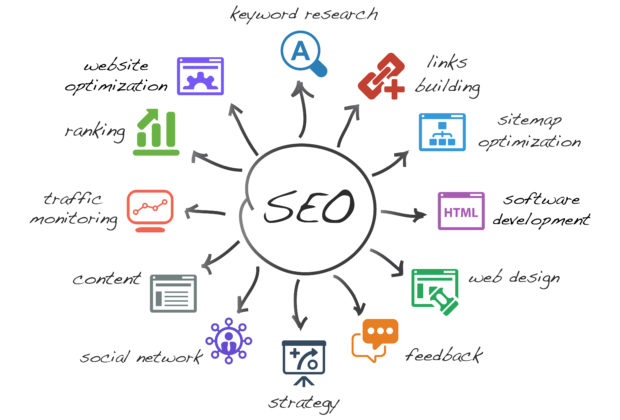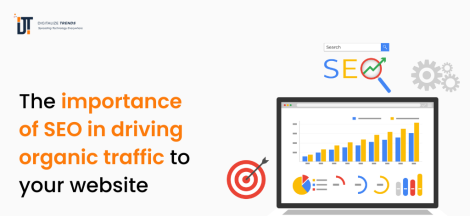These days, SEO has become a yardstick for measuring marketing endeavors in the digital world. It is considered the most effective strategy for improving the visibility of a brand and ensuring that it is not left out of search engine results for both local and global reach.
There is a prerequisite for SEO in the case of extensive content as it helps in link generation and citations. For businesses and services such as local plumbers, movers, it is considered enough to strap up an official website and a couple of landing pages. But SEO for eCommerce stores is another story.
The structure of the website and the type of content determines the direction and execution of SEO for an eCommerce store. In this post, we are going to devise a plan for marketing professionals that will help them in nailing down the details.
Developing A Sound Strategy
SEO plan for an eCommerce website may appear to be a daunting endeavor, especially if your website already has a large number of items. Yes, it will take time, but with the right plan, you can make these go faster.
Rank Pages
Which of your website’s pages receive the greatest traffic? Lead with them. Furthermore, if you want consumers to concentrate on a certain or flagship product, optimize for it first.
Make A Flow Chart for Improved Productivity
SEO necessitates a number of unique criteria. This includes selecting keywords, adding metadata, accurately identifying your photos, adding image alternative characteristics, and incorporating relevant keywords.
Competitors’ Analysis
The goal of your eCommerce SEO strategy should be aligned against outsmarting the competition. Examine the websites of your top competitors and their SEO routine to determine how you can improve yours.
Conversion Rate Optimization
SEO should be followed by conversion rate optimization (CRO). It is because there is no point in investing resources for lead generations and improved exposure if you do not have short- and long-term goals for lead generation.
Checklist-SEO Plan for eCommerce Website
SEO is about exploiting search engines algorithms in your brand’s favor for improved visibility and exposure. Instead of going through generic guidelines, here is a simplified, yet practical checklist to ensure you never miss out on the key points of your SEO strategy.
Keywords Are the Key
Keywords are still important. You don’t want to stuff these keywords into your product titles and descriptions, but they must appear somewhere in the writing.
In your product headline, description, meta description, image alternative attributes, and subheadings, include your major keyword. Keywords from the latent semantic index (LSI) should be sprinkled throughout. These are relevant keywords that Google uses to comprehend the context of your page.
Do some research on a keyword before using it. Know how frequently people look for it (keyword search volume), how competitive it is in the paid advertising space (cost-per-click, or CPC), and what they’re looking for when they use it.
Competitors’ Research
If you’re not sure where, to begin with, on-site SEO for your eCommerce site, look to your rivals. Larger rivals, in particular, are likely to have already put in the effort to optimize their websites, and many of their secrets may be found on their own websites.
The thing you should concentrate on is keywords. You’ll want to look at the keywords on their homepages and top product pages in particular. How can you know if a site is optimized for a specific keyword? Start by looking at your rivals’ title tags with the Moz browser plugin to discover what SEO title and description they use.
Home Page SEO
Most firms spend the majority of their SEO spending and effort on the homepage. While it is undoubtedly one of the most important pages to optimize on your website, it is far from the only one.
Having said that, you should optimize your homepage thoroughly. The following are some of the most important items to add and optimize.
Title Tag
One of the most significant aspects of on-site search optimization is the SEO title tag. It should include your company name as well as the major keyword phrase you’re aiming for. Because it will appear in search results, you should create this title tag in fewer than 70 characters and in a style that is engaging to search visitors.
Meta Description
The meta description for your homepage is a 160-character description of your business that will also appear in search beneath the title tag, although this one does not carry much weight in terms of keyword rankings. It should be written in a way that makes visitors want to go to your website, giving a sneak peek of what the page is all about.
Content
The information on your homepage should provide visitors with a clear and succinct overview of your company and the items you have to offer. Avoid providing too much information to visitors. Consider putting your top few goods and your unique selling proposition on the homepage.
UI
Stuffed homepages may be confusing to both visitors and search engines. For example, suppose you sell things in a variety of categories. Google will have a hard time figuring out what you sell and who you’re selling to, so be explicit about what your site has to offer.
Fortify Site Architecture
Remember that site architecture plays a vital role in search optimization when you add goods and categories to your store. From your homepage through product categories to the goods featured inside them, you should have a clear hierarchy of navigation.
A clean internal linking structure that is easy to follow and not too deep will help search engine bots locate your website’s pages and items. The rule of thumb for both search engines and users is that everything should be accessible in three clicks. They should only need to make three clicks from the homepage to access any product on your website.
Augmented Product Pages
Because product pages are the lifeblood of your company, you should devote a significant amount of time and effort to improving them. Many e-commerce business owners merely type a few lines describing each product and display an image or video.
More information on your product pages is required so that Google can discover them. Here are the exact areas where you wish to focus your efforts.
Product Name
It’s crucial that your product has a name. It’s also utilized in the SEO title and URL of your product page in most circumstances. This is why you should consider including a popular search term or keyword phrase in your product descriptions.
If you’re selling T-shirts, for example, make sure the product name includes the words “T-shirt” or “tee.” This is a sure-fire way to make sure your focus keywords end up in the name of the product.
Optimized Images and Photos
The images on your product page are crucial. Put yourself in the shoes of your consumer for a second. Are you more inclined to purchase a product from a site that clearly portrays it from as many angles as possible, a site with no image at all, or one that is tiny and illegible?
Images are vital not just for your consumers, but also for search engine optimization. Start with the file name to correctly optimize your photographs for search. IMG0010.jpg should not be included in your product pages. Instead, type velvet-summer-coat-mens.jpg as the product name and primary keyword.
Include keywords that people might use if you had alternate viewpoints of your goods.
Embedded Videos
You may assist your clients to feel more confident in their purchases by incorporating video on your product page. Simple product information (like a commercial), a how-to video on how to utilize the product to get results, or testimonials from people who have used it might all be included in the video.
Off-site video distribution on sites like YouTube might help you attract and educate potential customers about your company. In addition to product videos, you can embed videos, such as guides, and how-to’ s, on every page of products.
Feedback
Allowing reviews is another approach to increase client confidence in your product, so if you have a good one, do so.
Negative feedback isn’t necessarily a negative thing. Consider this: if you have a higher-priced item with excellent ratings and a lower-priced one with mediocre reviews, customers will choose the higher-priced item, resulting in more sales for your company.
Closing Remarks
Search Engine Optimization is a dynamic process that goes through different phases of development. Fundamentally, the process is different depending on the business type and structure of a site. This article was written in the spirit of imparting knowledge to marketers on how to improve visibility and exposure for their e-commerce websites. Unfortunately, many sites are eager to turn campaigns into solid profits which is why they often neglect the proper SEO structure of their websites. Through research and following these checklists, you can get a clear picture of what to do and how to do it in the least possible time. Also, you may track your competitor’s techniques for getting ideas. For instance, if you have a directory you will track some well-renowned business listing sites such as the CityLocal Pro and if you have to optimize an e-commerce site you will track some well e-commerce sites such as eBay.





 5 Best Ways To Choose A Digital Marketing Agency
5 Best Ways To Choose A Digital Marketing Agency
Very useful information. Many many thanks for this unique post.